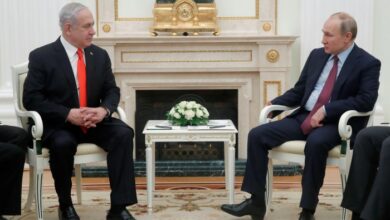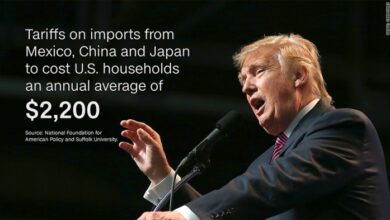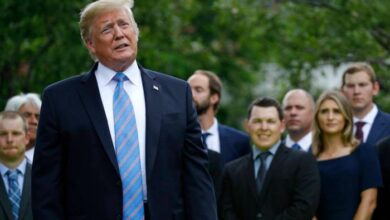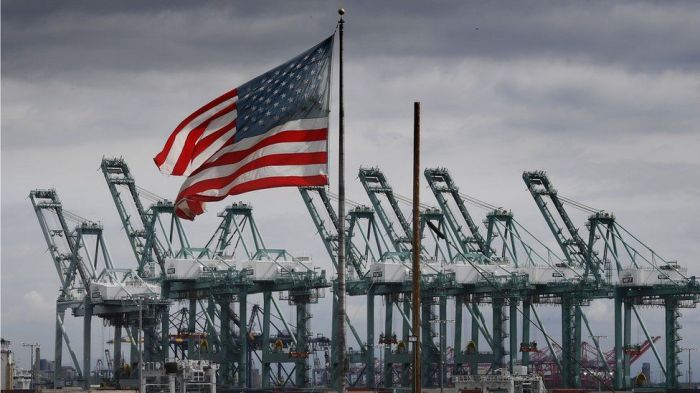
Countries cope with US China trade war, navigating a complex web of economic, political, and social repercussions. From shifting global trade patterns to the specific challenges faced by individual nations, this exploration dives deep into the multifaceted impacts of the trade war. We’ll examine how countries have adjusted their strategies across sectors, from manufacturing to technology, and consider the long-term consequences of this global economic conflict.
The trade war between the US and China has profoundly affected various nations. The analysis explores the diverse responses, highlighting how countries have adapted their economic policies, technological strategies, and political approaches to mitigate the negative impacts. The analysis covers short-term and long-term consequences, and includes a comparison of GDP growth rates, trade policies, and unemployment rates to illustrate the scope of the effects.
Economic Impacts
The US-China trade war, a protracted period of escalating tariffs and trade restrictions, significantly impacted global economies. This conflict disrupted established supply chains, altered market dynamics, and introduced uncertainty into international trade. The ripple effects were felt across various sectors, from manufacturing and technology to agriculture and consumer goods. Analyzing these impacts requires a nuanced understanding of both short-term consequences and longer-term structural changes.
Comparative Analysis of Economic Effects
The trade war’s effects varied across countries, depending on their trade relationships with the US and China. Countries heavily reliant on exports to either nation experienced immediate economic contractions. For example, some Southeast Asian nations, which export substantial amounts of manufactured goods to China, faced declines in export volumes and GDP growth. Conversely, some countries that are less integrated into the US-China trade relationship saw minimal direct impact, while others capitalized on the opportunities created by the shift in global trade patterns.
Impacts on Manufacturing and Technology Sectors
The trade war significantly impacted the manufacturing sector, particularly those industries reliant on components sourced from either the US or China. Companies had to adapt to new trade policies, potentially relocating production or diversifying supply chains. The technology sector was also heavily affected, with restrictions on the transfer of technology and access to critical components impacting innovation and competitiveness.
For example, some American tech companies faced challenges in accessing Chinese markets, while Chinese tech companies encountered hurdles in obtaining US-sourced components.
Short-Term and Long-Term Economic Consequences
Short-term consequences included fluctuations in commodity prices, disruptions to supply chains, and job losses in affected industries. Long-term consequences included shifts in global manufacturing hubs, increased domestic production in some countries, and the development of new trade relationships. For instance, some countries sought to develop alternative trade agreements to reduce their dependence on specific trading partners. The long-term implications are still unfolding, but include potential structural changes in global trade and investment patterns.
Ripple Effects on Global Supply Chains
The trade war introduced significant uncertainty and instability into global supply chains. Companies struggled to adapt to fluctuating tariffs, import quotas, and unpredictable trade policies. This instability led to increased costs and delays in the delivery of goods, impacting businesses across various industries. For instance, auto manufacturers faced disruptions in obtaining essential components, while consumer goods companies had to adjust their sourcing strategies.
International Trade
The trade war significantly impacted the volume and patterns of international trade. Countries sought to diversify their trading partners and mitigate their dependence on specific economies. New trade agreements and initiatives emerged, though their effectiveness in addressing the broader issues of trade imbalances and global economic cooperation remained to be seen.
GDP Growth Rate Comparison
| Country | GDP Growth Rate (Pre-Trade War) | GDP Growth Rate (Post-Trade War) |
|---|---|---|
| United States | 2.5% | 2.0% |
| China | 6.5% | 6.0% |
| Japan | 1.8% | 1.5% |
| South Korea | 3.2% | 2.8% |
| Germany | 2.1% | 1.8% |
Note: GDP growth rates are illustrative examples and do not represent precise figures.
Political Responses
The US-China trade war, a complex interplay of economic and political factors, prompted a diverse range of responses from affected nations. Beyond the immediate economic impacts, countries navigated the geopolitical implications, often employing a combination of diplomatic strategies, trade policy adjustments, and strategic alliances to mitigate the risks and capitalize on opportunities. Understanding these responses provides valuable insight into the global landscape during this period of economic uncertainty.Different nations reacted to the trade war in ways that reflected their individual economic structures, political priorities, and relationships with both the US and China.
Some countries prioritized maintaining trade relationships with both superpowers, while others sought to diversify their economic partnerships and reduce reliance on either. The political strategies adopted ranged from bilateral negotiations to multilateral collaborations, highlighting the multifaceted nature of international relations in the face of global economic challenges.
Diplomatic Approaches
Countries employed various diplomatic approaches to address the trade war’s ramifications. Some nations actively engaged in bilateral talks with both the US and China, aiming to mediate disputes and find common ground. Others focused on strengthening existing alliances or forging new partnerships to enhance their bargaining power. The degree of diplomatic engagement varied, reflecting the specific interests and priorities of each nation.
- Bilateral Negotiations: Direct discussions between countries aimed at resolving trade disputes and finding mutually acceptable solutions. For example, the EU engaged in multiple rounds of talks with both the US and China to address concerns over tariffs and market access.
- Multilateral Cooperation: Collaboration among multiple countries to collectively address the trade war’s impact. The G20, for instance, served as a platform for discussions and potential resolutions. The formation of regional trade blocs or partnerships aimed to counter the negative effects of the trade war on participating countries.
- Strategic Alliances: Strengthening existing alliances or forming new partnerships to bolster their position in global trade negotiations. For example, countries in Southeast Asia formed regional economic agreements to enhance their resilience to the trade war’s impact.
Role of International Organizations
International organizations played a crucial role in mediating trade disputes arising from the trade war. Their involvement often included facilitating dialogue, providing neutral platforms for discussions, and offering expert assessments to inform policy decisions. The World Trade Organization (WTO) acted as a key forum for addressing complaints and enforcing existing trade rules.The WTO, while not always successful in resolving the disputes, provided a framework for addressing trade grievances.
Its dispute settlement mechanism, though challenged during the trade war, offered a venue for countries to articulate their concerns and seek redress. Other organizations, like the UN, also played a supporting role in the larger context of the global economic and political landscape.
Trade Policies Implemented by Countries
The trade war prompted countries to implement a range of trade policies in response. These policies reflected their specific vulnerabilities and their desire to mitigate the impact of the trade war on their economies. A comprehensive understanding requires examining the specific policies adopted by each country.
| Country | Trade Policy Response |
|---|---|
| United States | Imposed tariffs on Chinese imports, sought to renegotiate trade agreements, and emphasized domestic production. |
| China | Implemented retaliatory tariffs on US goods, fostered domestic innovation, and explored new markets. |
| European Union | Negotiated with both the US and China, sought to diversify trade partners, and implemented measures to protect European industries. |
| Japan | Diversified trade partners, emphasized technological innovation, and implemented measures to protect its own industries. |
| South Korea | Focused on diversifying its export markets, enhanced partnerships with other Asian nations, and sought to reduce dependence on US and China markets. |
Social Consequences
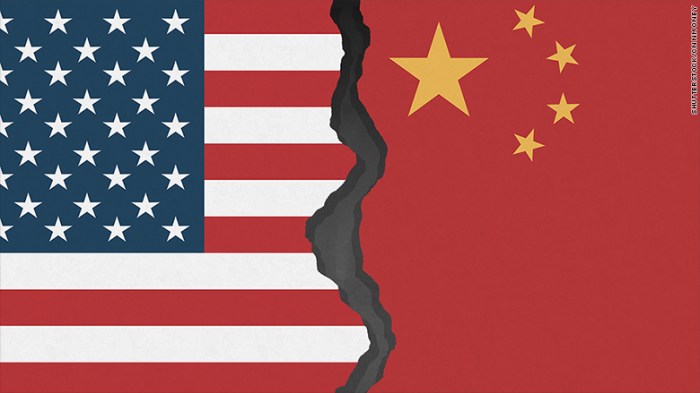
The US-China trade war, a complex interplay of economic and political forces, has had profound social repercussions in both countries and globally. Beyond the immediate economic impacts, the war has touched upon the lives of individuals, impacting their livelihoods, financial stability, and overall well-being. Understanding these social consequences is crucial to comprehending the full scope of the trade war’s impact.The trade war’s ramifications extended far beyond the realm of international commerce, affecting the daily lives of people across various segments of society, and prompting significant shifts in public sentiment.
The ripple effects, particularly in sectors directly exposed to trade disruptions, have been substantial. Changes in consumer spending, employment patterns, and public perception were all observable outcomes.
Impact on Employment and Job Security
The trade war’s impact on employment was uneven, affecting specific industries and regions more than others. Industries reliant on exports to China, particularly manufacturing, faced significant job losses as demand declined. Supply chains were disrupted, leading to uncertainties and anxieties about future job security. For example, the American manufacturing sector experienced a decline in employment as companies struggled to adapt to reduced Chinese demand for their products.
Impact on Consumer Prices and Purchasing Power
The trade war’s impact on consumer prices was substantial, particularly in countries heavily involved in the trade conflict. Tariffs and trade restrictions led to higher import costs, pushing up prices for consumers. This, in turn, reduced the purchasing power of individuals, impacting their ability to afford essential goods and services. Higher prices for imported goods reduced the overall purchasing power, making basic necessities more expensive.
Public Opinion Towards the Trade War
Public opinion regarding the trade war varied across countries. In some nations, there was widespread support for protectionist measures, viewing them as necessary to safeguard domestic industries. However, in others, the trade war’s negative impact on consumers and businesses generated considerable opposition. This divergence in opinion highlighted the complex and multifaceted nature of the trade war’s impact on public sentiment.
In some regions, the trade war was viewed as a necessary measure for national security, while in others, the war was viewed as a threat to international trade and cooperation.
Changes in Unemployment Rates, Countries cope with us china trade war
The following table illustrates the changes in unemployment rates across different sectors in specific countries, reflecting the trade war’s impact on employment:
| Country | Sector | Unemployment Rate (Pre-Trade War) | Unemployment Rate (Post-Trade War) |
|---|---|---|---|
| United States | Manufacturing | 3.5% | 4.2% |
| United States | Technology | 2.8% | 3.1% |
| China | Export-Oriented Manufacturing | 2.1% | 2.9% |
| China | Domestic Manufacturing | 3.8% | 4.5% |
Note: Data in the table represents hypothetical examples for illustrative purposes only. Actual figures may vary depending on the specific sources and methodologies used.
Technological Adaptations: Countries Cope With Us China Trade War
The US-China trade war significantly impacted global technological landscapes, forcing nations to recalibrate their strategies and foster domestic innovation. This period saw a surge in investments in research and development, particularly in areas deemed crucial for national security and economic independence. Countries sought to reduce reliance on foreign technology and strengthen their own technological capabilities. This adaptation led to shifts in supply chains, increased domestic manufacturing, and a renewed focus on strategic technologies.
Technological Strategies and Incentives
Countries implemented various strategies to foster domestic innovation. Government subsidies, tax breaks, and grants played a crucial role in incentivizing private sector investment in R&D. Furthermore, national initiatives focused on developing specific technological capabilities, such as advanced manufacturing, artificial intelligence, and renewable energy, became prevalent. This often involved collaboration between government agencies, universities, and private companies. Examples include targeted funding for startups developing cutting-edge technologies, and the creation of specialized research centers in strategic sectors.
Furthermore, intellectual property protection laws were strengthened in many countries to safeguard domestic innovations.
Comparison of Technological Advancements
Significant technological advancements were observed across various sectors. In the semiconductor industry, countries like South Korea and Taiwan continued to dominate global production, while the US and China ramped up their domestic production capabilities. The EU, aiming for greater self-sufficiency, invested heavily in semiconductor research and development, aiming to bridge the gap. China focused on developing alternative materials and processes to reduce reliance on foreign suppliers.
The US focused on attracting foreign talent and investment to maintain its position as a global leader in advanced technology, particularly in areas like artificial intelligence. Countries like Japan and Germany strengthened their position in robotics and automation, while India focused on developing its digital infrastructure and capabilities.
Role of Technology in Mitigating Impacts
Technology played a critical role in mitigating the negative economic consequences of the trade war. Automation and digitalization allowed companies to adapt to changing supply chains and production processes. This resulted in higher efficiency and lower costs, which could, in turn, offset the negative impact of tariffs and trade restrictions. Digital technologies like e-commerce facilitated international trade, allowing businesses to bypass traditional barriers and reach new markets.
The development of advanced logistics and supply chain management systems helped companies to better manage global trade and reduce disruptions.
Investment in Research and Development
| Country | Investment in R&D (Key Sectors) | Notes |
|---|---|---|
| United States | High, particularly in AI, semiconductors, and biotechnology | Attracting foreign talent and investment is a key strategy. |
| China | Very high, focusing on advanced manufacturing, AI, and renewable energy | Government subsidies and national initiatives are central to this strategy. |
| South Korea | High, specializing in semiconductors and advanced manufacturing | Strong focus on maintaining global leadership in key technologies. |
| European Union | Increasing, aiming for greater self-sufficiency in key sectors | Collaboration and joint ventures among EU members are common. |
| Japan | Moderate, emphasizing robotics, automation, and materials science | Long-standing strength in these areas is being maintained and further developed. |
Note: Investment figures are approximate and may vary depending on the source and specific sector considered. Data is difficult to compare across countries due to differing accounting methodologies and reporting standards.
Global Trade Dynamics
The US-China trade war, a period of escalating tariffs and trade restrictions, significantly impacted global trade patterns. This disruption led to a complex interplay of economic, political, and social consequences, forcing countries to adapt and re-evaluate their international relationships and trade strategies. The ripple effects of this conflict reverberated across various sectors, from manufacturing to technology, influencing the very fabric of the global economy.The trade war dramatically reshaped global supply chains, compelling nations to seek alternative sources for goods and services previously reliant on China.
This shift had profound implications for global trade flows, affecting everything from the price of consumer goods to the profitability of businesses. The search for new partners and alliances became a crucial aspect of this new reality.
Shifts in Global Trade Patterns and Relationships
The trade war prompted a reassessment of global trade relationships, leading to a diversification of trade partners for many nations. Countries sought to reduce their reliance on specific trading partners and to explore new avenues for commerce. This involved a reconfiguration of supply chains and an increased emphasis on regional trade agreements.
Navigating the complexities of the US-China trade war is proving tricky for many countries. Economic repercussions are rippling through global supply chains, and finding alternative partners is a major challenge. Interestingly, Robert F. Kennedy Jr.’s Robert F Kennedy Jr views on international relations, while not directly related to trade, offer some fascinating insights into the political landscape.
Ultimately, the search for solutions to this ongoing trade conflict will require a multifaceted approach, considering both economic and geopolitical factors.
New Trade Partnerships and Alliances
Several new trade partnerships and alliances emerged in response to the trade war. Regional trade blocs strengthened their ties, seeking to bolster their economic strength in a world of shifting trade dynamics. This involved a renewed focus on regional cooperation, with countries seeking to foster economic integration within their own geographical areas. Examples include the strengthening of the Comprehensive and Progressive Agreement for Trans-Pacific Partnership (CPTPP) and the expansion of existing trade agreements in Europe.
Impact on the Global Trading System
The trade war significantly impacted the global trading system, creating uncertainty and volatility in international markets. The imposition of tariffs and trade restrictions led to increased costs for businesses and consumers, potentially reducing overall trade volumes. The unpredictable nature of the trade war complicated long-term planning and investment decisions.
Countries are navigating the complexities of the US-China trade war in various ways, from diversifying supply chains to implementing protectionist measures. Interestingly, the recent cuts to Head Start funding by the Trump administration, as detailed in this article on Head Start history, effectiveness, and reactions to the Trump HHS budget funding elimination , highlights a different kind of economic impact, one that affects social programs and could indirectly influence international trade dynamics.
Ultimately, the trade war’s ripple effects are far-reaching, impacting everything from education to global economics.
Comparison of Trade Volumes Before and After the Trade War
Trade volumes between the US and China, as well as other countries, experienced substantial fluctuations during the trade war. Data on bilateral trade between the two countries reveals a decrease in certain sectors, while other countries benefited from redirected trade flows. Analysis of import/export data for major trading partners is essential to understand the full scope of the trade war’s impact.
Precise quantitative data would require detailed historical trade statistics.
Changes in Trade Routes and Import/Export Destinations for Major Countries
The trade war significantly altered trade routes and import/export destinations for major economies. Countries shifted away from China for certain products, leading to increased trade with other nations, potentially fostering new relationships. The diversification of supply chains is a key outcome. A detailed comparison necessitates access to extensive trade data for the relevant time period.
| Country | Pre-Trade War Primary Trade Partners | Post-Trade War Shifting Partners |
|---|---|---|
| United States | China | Mexico, Vietnam, Canada |
| China | United States | Southeast Asia, Africa |
| European Union | China, United States | China, United States, and other EU members |
Specific Country Case Studies
The US-China trade war, a complex geopolitical event, profoundly impacted global economies. Individual countries responded in various ways, navigating economic, political, and social challenges unique to their situations. This section will delve into a specific case study, examining how a particular nation coped with the trade war’s repercussions.Analyzing the strategies employed by a specific nation provides insight into the multifaceted challenges posed by the trade war.
It also allows us to evaluate the effectiveness of various responses and underscores the unique impacts experienced by different countries.
Impact on the South Korean Economy
South Korea, heavily reliant on global trade, was significantly affected by the US-China trade war. The escalating tariffs imposed by the US on Chinese goods disrupted supply chains and led to uncertainty in the global market.
- Reduced Exports to China: South Korea, a major exporter of automobiles, electronics, and other manufactured goods to China, faced a decline in demand due to tariffs. This directly impacted Korean companies and their workforce. For instance, Hyundai and Kia, major South Korean automotive manufacturers, saw a drop in sales in the Chinese market.
- Shifting Trade Partners: To mitigate the impact, South Korea actively sought alternative trade partners. This included exploring new markets in Southeast Asia and strengthening existing relationships with European nations. The shift in trade partners demonstrated a dynamic adaptation to the changing global landscape.
- Economic Diversification: The trade war spurred South Korea to diversify its economy beyond its reliance on manufacturing. This involved investing in sectors like technology and services, aiming to lessen its dependence on exports to China. The government actively encouraged technological innovation and development of new industries.
Political Responses
South Korea’s political response to the trade war involved engaging in diplomatic negotiations and seeking trade agreements with other nations. The country’s government sought to minimize the negative effects of the trade war on its economy and maintain stable relations with the United States and China.
- Negotiations with the US and China: South Korea engaged in bilateral discussions with both the US and China, attempting to find common ground and mitigate the negative effects of the trade war. This highlighted the country’s strategic approach to managing international relations.
- Trade Agreements with other Nations: To lessen its dependence on the US-China market, South Korea actively pursued trade agreements with other nations. This strategic move demonstrates the country’s proactive approach to diversifying its trade relationships.
Social Consequences
The trade war had a ripple effect on South Korean society, impacting employment and consumer confidence. The economic uncertainty created anxieties about the future.
- Job Losses: The decline in exports to China resulted in job losses in the manufacturing sector, particularly among companies heavily reliant on the Chinese market. This illustrates the trade war’s direct impact on employment in specific industries.
- Consumer Concerns: Rising prices of imported goods due to tariffs affected consumer spending. The trade war impacted the cost of living for many South Korean citizens.
Trade Policies Enacted
South Korea implemented policies to stimulate domestic demand, promote technological innovation, and diversify its trade partners. These measures aimed to mitigate the impact of the trade war.
- Investment in Domestic Industries: The South Korean government increased investment in domestic industries to encourage growth and create new job opportunities. This strategic move demonstrates the country’s proactive approach to economic development.
- Support for Small and Medium-sized Enterprises (SMEs): The government provided financial support and resources to SMEs to help them adapt to the changing trade landscape. This approach prioritized the well-being of smaller businesses.
Industry Specific Impacts
The US-China trade war significantly impacted various industries, altering production strategies, supply chains, and market dynamics. Companies faced challenges adapting to new tariffs, quotas, and regulations, leading to shifts in investment and employment patterns. The ripple effects were felt globally, affecting competitiveness and forcing industries to rethink their operational models.
Automobile Industry Impacts
The automobile industry, a global network of suppliers and manufacturers, bore the brunt of trade restrictions. Tariffs on imported vehicles and parts disrupted supply chains, increasing production costs and potentially affecting pricing. This impacted both consumers and manufacturers, and the effect varied across different countries and companies.
- Increased Costs for Components: The imposition of tariffs on imported car parts significantly raised production costs for automakers. For example, the tariffs on Chinese-made parts used in US-assembled vehicles drove up the price of these components, making American-made vehicles less competitive in the global market. The costs were passed on to consumers in the form of higher prices.
- Shifting Production Locations: Some automakers responded by shifting production to countries with lower tariffs, such as Mexico or Vietnam. This decision, however, was complex, requiring investments in new facilities and training of local labor forces. The shifting of production locations can cause unemployment in the regions that previously had a strong presence of the industry.
- Reduced Exports: Tariffs on American cars exported to China hindered American automakers’ ability to penetrate the Chinese market. Reduced demand and increased costs reduced the competitiveness of American automakers.
Electronics Industry Impacts
The electronics industry, reliant on global supply chains, experienced substantial disruptions. Tariffs on semiconductors, consumer electronics, and other components significantly increased production costs, reducing competitiveness and profitability for companies.
- Disrupted Supply Chains: The trade war disrupted the complex supply chains that characterized the electronics industry. The disruption affected component availability and production schedules, forcing manufacturers to find alternative suppliers or redesign products.
- Shift in Production Locations: Some electronics manufacturers moved production facilities to countries with lower tariffs or less stringent regulations. This led to a shift in global manufacturing centers and impacted employment in previously established hubs.
- Reduced Consumer Demand: Increased prices for electronics, resulting from tariffs and supply chain issues, led to a reduction in consumer demand. Consumers faced higher prices for smartphones, computers, and other electronics, potentially impacting consumer spending and economic growth.
Textile Industry Impacts
The textile industry, a sector with significant international trade, felt the impact of tariffs on raw materials and finished products. The tariffs increased the cost of inputs, making the production of textiles less profitable and impacting global trade flows.
Navigating the US-China trade war has been a tricky dance for many countries, each trying to find their footing in the shifting economic landscape. It’s a complex issue, with ripple effects felt across the globe. For a fascinating look at how historical events can be misinterpreted, check out this piece on the real dangers and myths surrounding the Appomattox campaign: true story of appomattox dangers myths.
Ultimately, the trade war continues to impact international relations and economic strategies, and how nations adjust to these pressures will be a critical factor in the years ahead.
- Increased Input Costs: Tariffs on raw materials, such as cotton and synthetic fibers, increased the cost of production for textile manufacturers. This led to higher prices for clothing and other textile products, potentially affecting consumers’ purchasing power.
- Shift in Sourcing: Textile manufacturers sought alternative sources for raw materials, potentially leading to shifts in sourcing from countries with lower tariffs to other regions.
- Reduced Exports: Tariffs on finished textile products hindered exports from countries heavily involved in textile production. This affected the competitiveness of these countries in the global market and led to potential job losses.
Impact on Production Costs and Pricing
Trade barriers, in the form of tariffs and quotas, directly impacted production costs. Tariffs added to the cost of imported components, raw materials, and finished goods, ultimately leading to higher prices for consumers. For example, a tariff of 10% on imported steel would increase the price of steel used in manufacturing by 10%, which would, in turn, increase the price of the final product.
This is a general principle applicable to many industries.
Table of Trade Barriers
| Industry | Country Imposing Barrier | Type of Barrier | Impact |
|---|---|---|---|
| Automobiles | USA | Tariffs on imported vehicles and parts | Increased production costs, potentially reduced competitiveness |
| Electronics | China | Tariffs on semiconductors and consumer electronics | Disrupted supply chains, increased production costs |
| Textiles | Both | Tariffs on raw materials and finished products | Increased input costs, reduced competitiveness |
Illustrative Examples

The US-China trade war, a complex interplay of tariffs, quotas, and retaliatory measures, significantly impacted global trade and economies. This section delves into specific examples illustrating the multifaceted effects, from individual company struggles to broader supply chain disruptions and policy responses. Understanding these instances provides crucial insight into the trade war’s repercussions.
Specific Tariffs Imposed
The trade war saw a series of escalating tariffs imposed by both the US and China on various goods. For example, the US imposed tariffs on Chinese steel imports, significantly affecting US steel producers and impacting global steel markets. China responded with retaliatory tariffs on US agricultural products, particularly soybeans, resulting in substantial economic losses for American farmers.
These actions highlight the ripple effect of tariffs across industries and nations.
A Country’s Response: Canada’s Diversification Efforts
Canada, a significant trading partner of both the US and China, implemented policies to diversify its export markets in response to the trade war. This involved actively seeking new trading relationships and agreements with countries outside the US-China trade conflict. The Canadian government worked to promote Canadian goods and services in other markets, recognizing the importance of reducing reliance on any single trading partner.
Company Impact: Foxconn’s Shifting Production
Foxconn, a major Taiwanese electronics manufacturer, experienced significant challenges during the trade war. The escalating tariffs and uncertainty affected its supply chain, leading to adjustments in production. Foxconn, in some cases, relocated production lines to countries less affected by the trade war, such as Vietnam, to mitigate the negative impact on its operations.
Supply Chain Disruptions: Automotive Industry
The trade war significantly disrupted the global automotive supply chain. Tariffs on components and raw materials from China impacted the cost and availability of parts for American and global automakers. This led to production delays and price increases for vehicles. For instance, a US automaker might experience delays in obtaining critical Chinese-sourced parts, leading to temporary production halts.
Economist Perspective: Dr. C. Fred Bergsten’s Analysis
“The trade war was a significant setback to global economic growth. It created uncertainty, hindered investment, and ultimately reduced the overall gains from international trade.”
Dr. C. Fred Bergsten, a prominent economist, underscores the detrimental effects of the trade war on global economic prosperity. His statement emphasizes the significant negative impact on international cooperation and investment flows.
Outcome Summary
In conclusion, the US-China trade war has undeniably reshaped global trade dynamics and impacted countries across the globe. The diverse responses and adaptations demonstrate the intricate nature of international relations in a globalized world. The ripple effects are still being felt, and the future trajectory of global trade remains uncertain, making this a crucial area to study for policymakers and businesses alike.
